Up to Sunderland to cat sit for Scott as he took a break with G and family down in Somerset. It now feels like a long journey (obviously, it’s exactly the same length but we’re now doddery old people) so we broke the journey by staying overnight at the Wentbridge House Hotel just off the Al. Wedding on the day we arrived and the next day but we were never rushed or hurried. In fact we had a pleasant chat with the very recent bride and groom in the bar as they took a break before the reception in the Crystal Room.
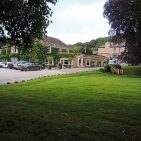
Just to be sure we’d booked an evening meal in the brasserie, even though I was convinced we’d probably be alone in there. As usual, preconceptions were proven completely off kilter as every table was in use. Even full, and with the wedding party to cater for, the meal was both excellent and nicely presented. Breakfast the next morning was equally fine. It’s not cheap, but it is worth it. Following breakfast, we had a little wander around Wentbridge before setting off North.

On our way up, we called in to see Newby Hall, which, sadly, was neither National Trust or English Heritage. Quite pricey, but as the Hall interiors weren’t fully open, we got some kind of saver ticket that came in handy for the extended family. Newby is is one of England’s renowned Adam houses and an exceptional example of 18th century interior decoration. Built in the 1690s by Sir Christopher Wren the house was later enlarged and adapted by John Carr and subsequently Robert Adam. Worth it for this alone but the gardens were also extensive and worth the wander in which we indulged. Award winning gardens, mostly created in the early 1920s, they have evolved over the years making a major contribution to 20th century gardening.
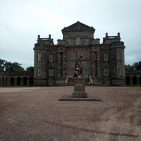
Arrived in Sunderland ans Scott and G set off early the following morning (too early for me). Our first visit was to Seaton Deleval Hall,which was National Trust and which proved to be fascinating to visitors for any number of reasons. Firstly, it was one of the architect Sir John Vanbrugh’s smallest country houses; more importantly, it was home to the larger than life Delaval family. The house and surrounding landscape were in keeping with the style expected in Georgian society, yet behind the formality lies a story of theatrical mischief. Secondly, the family was known as the ‘Gay Delavals’ due to their high spirited and flamboyant lifestyle; an invitation to one of their parties was the hottest ticket in town. In an age notorious for extremes of behaviour, they stood apart as the most notorious of all Georgian partygoers and pranksters. Imagine awaking in the house to find your room “turned upside down” with furniture fixed to the ceiling. Thirdly, it still bears the scars of the fierce fires which almost condemned it to ruin two hundred years ago, but even today plays a major part in the history of the North East. A true find and I was sufficiently motivated to buy the book “The Delavals, A Family History” by Martin Green in the Trust Gift Shop. Two Cream Teas in the cafe as well so I believe we compensated adequately for the ‘free’ entry. 🙂

Also walked into Seaton Sluice, a village divided by a bridge, across the Seaton Burn, situated in Northumberland. It lies on the coast at the mouth of the Seaton Burn, midway between Whitley Bay and Blyth. It has a population of about 3,000 people. Lovely small harbour and coastline, it was probably worth more than the hour or so that we had allowed.
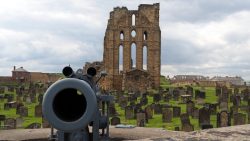
Another day, another trip, this time to Tynemouth and the associated Priory, situated on the headland, overlooking the North Sea and the River Tyne. The Priory has had many purposes throughout its history, including an Iron Age settlement, an Anglo-Saxon monastery, a royal castle and a coastal defence. The gun battery was designed to defend the Tyne in the First and Second World Wars. Like so many others, in January 1539 the priory fell victim to the nationwide Dissolution of the Monasteries. All the priory lands and possessions were surrendered to the king, St Oswine’s shrine was destroyed and monastic life at Tynemouth came to an end. Given that its inception as a monastery was around the 8th Century, it could be argued that Henry VIII’s desperation for an heir had a lot to answer for. But it was English Heritage, so another one in the pro column!

Our next venture was closer to home, as we took the opportunity to revisit the National Glass Centre on the Wear – the pretext was a booked timing to see Gormley’s 1993 “Field for the British Isles“, which is in essence an installation of 50,000 miniature terracotta figures. Much of what Gormley has produced can be immensely moving but this was underwhelming; hardly the Terracotta Army, five minutes was more than sufficient. More impressive was the exhibition of articles created entirely of Beads called “No Strings“. ‘No Strings’ features the work of seven international artists working with glass beads in unconventional ways. The exhibition includes a beaded burger and coke by Faranak Sohi, an evening dress made using beads and safety pins by Shige Fujishiro and a beaded chicken showing his gymnastic prowess on the rings by Felieke van der Leest. It didn’t all work, but the best of the exhibition was superb.

After leaving Sunderland (cat sitting accomplished successfully), we stopped off at the unusual but very satisfying Rossington Hall. The new Hall was was built and ready for occupation in 1883. The building incorporated a portico, entrance hall, dining room, library, staircase hall, conservatory, and drawing room, all of which have been painstakingly restored by the current owner. We had a lovely bedroom (Humble View) and excellent dinner on two of the three nights we were there. It’s an idiosyncratic environment and it clearly has a few issues but we loved it. We trust it succeeds before its owner runs out of funding!
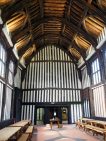
Whist staying at the Hall we took the opportunity to visit Gainsborough and, specifically, the Old Hall, which was possibly the biggest positive shock of the whole trip. It is described, accurately, as a little known gem! It is claimed it is one of the best preserved medieval manor houses in England with an impressive medieval kitchen with an enormous fireplace and a great hall with ornate wooden ceiling. All true and English Heritage have done a wonderful job with the restoration; we timed it well, as the Hall had only just reopened following the planned conservation works. Given the history and various uses to which the building has been put over the years (theatre, housed tenements, public house etc.), it’s a truly remarkable survival.
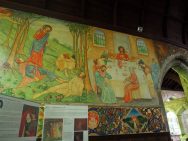
On our way back we spotted the sign to Traquair Murals in St. Peter’s Church and took a chance. Another surprise, the church chancel is decorated with fine murals by the renowned Scottish artist Phoebe Anna Traquair 1852-1936. The murals were completed in 1905 and make the village (Clayworth) and church a more than worthy sidestep.

Our final visits were the English Heritage run Roche Abbey, which has one of the most complete ground plans of any English Cistercian monastery, laid out as excavated foundations. To be honest, we’ve seen a few free Heritage sites that were more impressive (or historically valued) than the Abbey and would have been aggrieved to have been asked to pay to walk the grounds, especially as free walking routes are available to all about one yard beyond the paid perimeter. As members it felt a little like a mis-step. It was impressive, but far from exceptional. From there we moved onto Brodsworth Hall and Gardens, which, pleasurably, we both remembered we had been to previously. Another EH site, this ‘conserved as found’ country estate was built and the pleasure gardens laid out in the 1860s as an up-to-date new home for the Thellusson family and their servants.
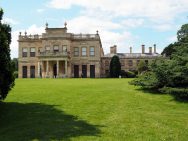
It survived with remarkably few changes until taken on by English Heritage in 1990. The gardens have been restored and the faded and worn interiors gently conserved, telling the story of the changing fortunes of the people who lived and worked here. I remembered it quite well, although Covid retrictions meant we saw less of the interiors than on our previous visit. Had a chat with one of the guides about Peter Thellusson’s infamous will, bought the guide book to flesh out the complexities and still don’t fully understand it. Definitely getting old!
Catsitting, familiar and new hotels, a range of historic sites (some surprisingly exceeding expectation) and no major senior moments. What’s not to like……
